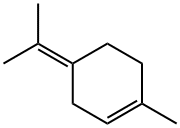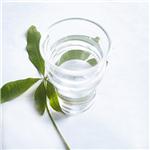Chemical Properties
Colorless liquid
Chemical Properties
Terpinolene has a pleasant sweet-piney odor with a somewhat sweet, citrus flavor.
Occurrence
Reported found in citrus juices and oils, black currant, guava, papaya, raspberry, various spice and mint oils, tea, passion fruit, litchi, lovage oil, distilled lime peel oil, ginger, nutmeg, pepper, mace, coriander seed, lovage seed, lovage root, myrtle leaf, pimento berry, pimento leaf, winter savory, smaller galanga, Ethiopian or guinea pepper and ashanti pepper.
Uses
Solvent for resins, essential oils; manufacture
of synthetic resins, synthetic flavors.
Definition
ChEBI: A p-menthadiene with double bonds at positions 1 and 4(8).
Production Methods
Terpinolene used to be extracted by fractional distillation of wood turpentine. It is now produced bytreatinga-pinene with aqueous H3PO4 at 75 ℃. It is preferable to distill terpinolene under vacuum to minimize the formation of polymeric products at elevated temperatures.
Preparation
By alcoholic sulphuric acid treatment of pinene (Arctander, 1969).
Aroma threshold values
Aroma characteristics at 1%: sweet, fresh, piney citrus with a woody, old lemon peel nuance.
Taste threshold values
Taste characteristics at 2 to 25 ppm: woody, terpy, lemon and lime-like with a slight herbal and floral nuance.
General Description
A water-white to light amber colored liquid. Insoluble in water and less dense than water. Flash point 99°F. Used to make plastics and resins.
Air & Water Reactions
Highly flammable. Insoluble in water.
Reactivity Profile
Terpinolene may react vigorously with strong oxidizing agents. May react exothermically with reducing agents to release hydrogen gas. In the presence of various catalysts (such as acids) or initiators, may undergo exothermic addition polymerization reactions.
Hazard
Flammable, moderate fire risk.
Health Hazard
Inhalation or contact with material may irritate or burn skin and eyes. Fire may produce irritating, corrosive and/or toxic gases. Vapors may cause dizziness or suffocation. Runoff from fire control or dilution water may cause pollution.
Flammability and Explosibility
Not classified
Pharmacology
Combinations of terpenes, such as terpinolene, with nonionic surfactants and stabilizers
have been patented for use as gallstone solvents. Human cholesterol calculi heated in mixtures
containing terpinolene and human bile were dissolved within 1-2 hr (Hisamitsu Pharmaceutical Co.,
Inc., 1973).
Safety Profile
Mildly toxic by ingestion. A very dangerous fire hazard when exposed to heat or flame. To fight fire, use foam, CO2, dry chemical. Can react with oxidning materials. When heated to decomposition it emits acrid smoke and irritating fumes.






